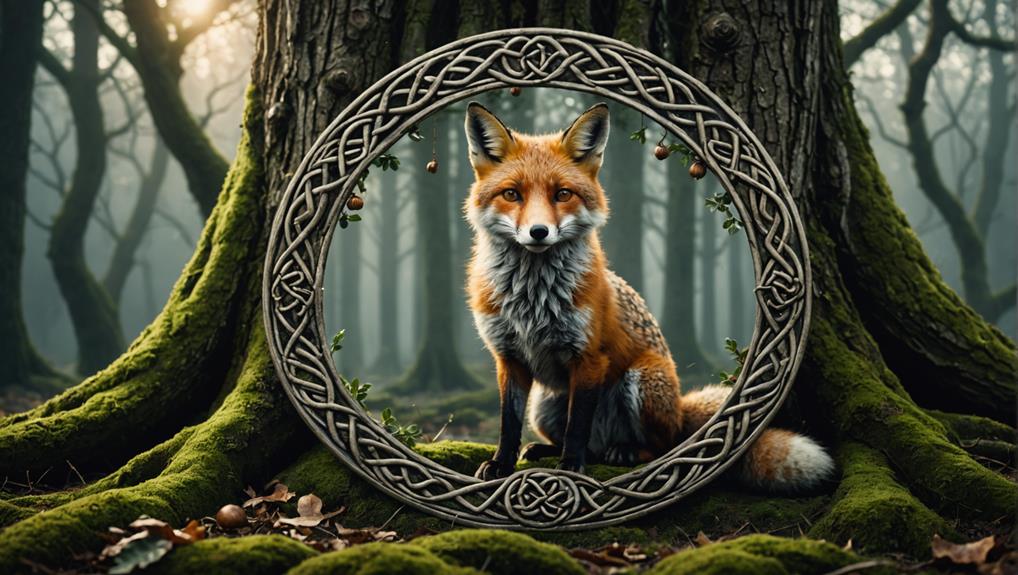As you explore European mythology, you'll discover that foxes embody a complex mix of traits, from cunning tricksters to wise guides, reflecting the dualities of human nature. These sly creatures symbolize intelligence, resourcefulness, and adaptability, often outsmarting stronger animals in folktales like "Reynard the Fox." Representing both positive and negative qualities, foxes challenge societal norms and moral lessons, as seen in Aesop's Fables. As you venture deeper into the symbolism of foxes, you'll uncover more layers of their multifaceted nature, revealing the intricate complexities of human morality and the secrets that lie within.
Contents
Fox Symbolism in Folklore
In the realm of European folklore, foxes emerge as cunning tricksters, often outsmarting stronger animals and symbolizing intelligence and resourcefulness. You'll find these clever creatures in tales like "Reynard the Fox," where their wit and cunning allow them to outmaneuver more powerful foes.
But what makes the fox such a compelling character? For one, it embodies both positive and negative traits, reflecting the duality of human nature. On one hand, the fox is clever and resourceful; on the other, it's deceitful and manipulative. This complexity makes the fox a fascinating symbol, and its presence in Aesop's Fables highlights the importance of shrewdness and the dangers of gullibility.
In Slavic culture, the fox represents resilience and survival against adversity, while folktales like "The Wolf and the Fox" show how intellect can triumph over brute strength.
As you explore European folklore, you'll discover the cunning fox is a recurring symbol, reminding you that wit and intelligence can be just as powerful as brawn.
The Trickster Archetype Unveiled
Many cultures in European mythology feature the fox as a central figure in the trickster archetype, embodying cunning, cleverness, and the ability to outmaneuver opponents.
You might be familiar with Reynard the Fox, a medieval character who represents the cunning and deceptive qualities associated with the trickster figure. He often challenges the status quo and societal norms, making him a fascinating and complex character.
In Aesop's Fables, the fox frequently employs trickery to illustrate moral lessons, demonstrating the cleverness of wit over strength in survival scenarios.
This theme is also present in Eastern European folklore, where foxes outsmart larger, stronger animals, reinforcing the idea that intellect can triumph over brute force.
The duality of the fox as both a benefactor and antagonist in trickster tales serves to reflect the complexities of human nature, where deception can lead to both chaos and clever resolutions.
As you explore the symbolism of foxes in European mythology, you'll discover how the cunning nature of the fox continues to captivate and inspire us.
Cultural Significance Across Europe

As you explore the cultural significance of foxes across Europe, you'll notice they're woven into the fabric of various folklores, often embodying contradictory traits.
In some tales, they're sly tricksters, while in others, they symbolize wisdom and guidance.
From Slavic to Scandinavian cultures, the fox's role is multifaceted, reflecting the complexities of human nature and the moral choices we face.
Foxes in Folklore
You encounter foxes in European folklore as masters of wit and deception, always staying one step ahead of their adversaries.
Foxes were seen as cunning tricksters, often depicted outsmarting stronger animals and humans in tales such as "Reynard the Fox" and various Aesop's Fables. Their cleverness is illustrated through numerous folktales, where they employ their wit and agility to navigate challenges, symbolizing intellect over brute strength.
In Slavic mythology, foxes are linked to the deities Weles and Dziewanna, embodying themes of resilience, cunning, and the ability to outmaneuver powerful forces.
Medieval bestiaries often presented foxes as metaphors for both wisdom and deception, warning society of the dangers posed by those who appear charming but are truly manipulative.
Through these stories, you see that foxes represent the complexities of human behavior and moral choices across cultures.
Fox Mythology Roles
Across European cultures, foxes assume diverse roles, reflecting the complexities of human nature and the importance of wit, cunning, and adaptability.
You'll find that these clever creatures embody a range of characteristics, from tricksters to guides, and even symbols of good fortune.
In Slavic mythology, the fox is tied to Weles, the god of the underworld, representing resilience in the face of deception and power struggles.
Meanwhile, in Celtic mythology, the fox serves as a guide between the realms of the living and the spirit world, symbolizing wisdom and the journey of self-discovery.
As you explore Germanic tales, you'll encounter the fox as a cunning observer, as seen in "The Fox and the Grapes," which teaches us about envy and rationalization.
In Finnish folklore, the fox is a bringer of good fortune, associated with the sacred and magical elements of nature.
The fox spirit is woven throughout these roles, embodying the complexities of human nature and the importance of wit and cunning.
Foxes in Mythological Stories
Medieval literature is replete with tales of cunning foxes, and one of the most iconic figures in European mythology is Reynard the Fox, a master of survival and trickery.
You'll find that Reynard's cleverness is a recurring theme in many mythological stories, often pitted against stronger adversaries. For instance, in Aesop's "The Fox and the Grapes," the fox's clever rationalization serves as a cautionary tale about envy and self-deception.
In Celtic mythology, the fox takes on a more spiritual role, guiding you between human and otherworldly realms with wisdom and cunning.
Meanwhile, Slavic folklore showcases the fox's intellect, outsmarting other animals in tales like Kolobok, where the fox persuades the protagonist with cunning wit.
Medieval bestiaries frequently feature foxes engaging in deceptive behavior, serving as moral allegories to warn against relying on superficial charm.
As you explore these mythological stories, you'll discover that the fox's cunning nature is a thread that weaves through various cultural traditions, teaching valuable lessons about wit, adaptability, and the power of clever thinking.
Spiritual Associations of Foxes

As you explore the spiritual associations of foxes, you'll discover that they're often seen as guides who help you navigate life's twists and turns.
With their cunning nature and adaptability, foxes embody wisdom that encourages you to trust your instincts and make smart choices.
From facilitating transitions between the human and spiritual realms to representing resilience and cleverness, foxes have earned their spot as revered spiritual beings in many mythologies.
Fox as Spirit Guide
Delving into the realm of European mythology, you'll discover that the fox is revered as a spirit guide, navigating the threshold between the physical and spiritual realms.
This cunning creature is believed to offer wisdom and protection to those on their journey, helping individuals traverse unknown territories and facilitating personal discovery and transformative experiences.
As a spirit guide, the fox is attributed with several key qualities that make it an effective navigator of the spiritual realm. Here are four ways the fox spirit guide can support you:
- Illuminating dark paths: The fox's luminous eyes symbolize its ability to shed light on confusion and uncertainty, guiding you towards enlightenment.
- Guarding secrets: The fox is a guardian of secrets, helping you uncover hidden truths and mysteries of the universe.
- Embracing adaptability: The fox's spiritual associations extend to themes of adaptability and agility, encouraging you to embrace change and overcome challenges in your personal and spiritual life.
- Balancing dual nature: The fox's dual nature as a clever protector and cunning trickster reflects the complexities of human nature, reminding you to acknowledge and balance your own contradictions.
Cunning Wisdom in Nature
Beyond its role as a spirit guide, the fox's cunning wisdom is deeply rooted in nature, reflecting its remarkable ability to navigate both the natural and social landscapes with agility and insight.
As you delve into European mythology, you'll find that the fox is often revered as a symbol of cunning wisdom, embodying the qualities of adaptability, intelligence, and survival. Folktales frequently position the fox as a teacher or mentor figure, imparting valuable lessons about the importance of being quick-witted and resourceful in the face of challenges.
In Renaissance art, the fox symbolizes moral caution, highlighting the duality of intellect and temptation, where wisdom is both celebrated and warned against.
The fox's cunning wisdom serves as a reminder to harness your intelligence and instincts to navigate life's complexities, while remaining mindful of the fine line between wisdom and temptation.
Guardians of Hidden Knowledge
In the realm of European mythology, foxes emerge as enigmatic guardians of secret knowledge, weaving a mystical tapestry that bridges the physical and spiritual realms.
As you delve into the symbolic world of the fox, you'll discover a rich tapestry of spiritual associations that reveal the depth of its mystical significance.
Here are four key aspects of the fox spirit as guardians of hidden knowledge:
- Mediators of the unknown: In Celtic mythology, the fox is seen as a mediator between the physical and spiritual worlds, guiding individuals on their journeys of self-discovery.
- Keepers of wisdom: The cunning nature of foxes positions them as keepers of wisdom, reflecting their ability to navigate between different realms and provide insight to those who seek it.
- Illuminators of hidden paths: In various folktales, the fox is depicted as leading characters through treacherous landscapes, representing the illumination of hidden paths and guiding towards enlightenment.
- Balancers of light and shadow: The duality of the fox's character—both clever and playful—embodies the balance between light and shadow, highlighting its role as an essential figure in the pursuit of hidden truths.
As you explore the symbolism of the fox, you'll find that its role as a guardian of secret knowledge is rooted in its ability to navigate the mystical realms, guiding you towards a deeper understanding of yourself and the world around you.
Interpreting Fox Encounters Today
Many a time, you've caught a glimpse of a fox darting across your path, leaving you wondering what this unexpected encounter might mean. As you ponder the significance of this chance meeting, you may find yourself drawn to the symbolic meanings associated with the fox spirit.
In contemporary encounters, many individuals perceive foxes as symbols of intuition and adaptability, reflecting their cunning nature in folklore. If a fox has crossed your path, it may be an omen, urging you to tap into your inner cleverness and resourcefulness in life decisions.
With urban fox sightings on the rise, it's no wonder that wildlife enthusiasts are fascinated by these creatures. Close encounters with foxes are often regarded as a sign of good luck and potential transformation.
As you reflect on your own encounter, consider the message the fox might be conveying. Are you being called to adapt to changing circumstances or trust your intuition?
The fox's presence may be a gentle nudge, encouraging you to embody the qualities it represents. By embracing the symbolic meaning behind your encounter, you may unlock a deeper understanding of yourself and the world around you.
Modern Reflections of Fox Symbolism

Witnessing foxes in modern media and art, you're likely to notice their enduring symbolism. The cunning and intelligent nature of foxes continues to captivate audiences, reflecting societal dynamics and complexities. In contemporary media, foxes embody complex characters, as seen in animated films like "Fantastic Mr. Fox" and Disney's "Zootopia".
Here are some examples of modern reflections of fox symbolism:
- Literary Rebirth: Modern literature often reinvents fox symbolism, exploring themes of transformation and duality in narratives that blend human and fox experiences, as seen in works by Kij Johnson and Elizabeth Hand.
- Playful Imagery: Foxes continue to be a popular motif in children's literature, showcasing their playful and crafty nature, and encouraging lessons about wit and resourcefulness.
- Brand Ambassadors: Recent studies have highlighted the adaptability of fox symbolism in branding and fashion, reinforcing the idea of foxes as representations of cleverness and allure in popular culture.
- Artistic Expression: Fox imagery is frequently used in visual arts today, symbolizing themes of resilience and cunning, inviting viewers to reflect on the complexities of human nature and social interactions.
In these modern reflections, the fox spirit shines through, reminding us of the power of adaptability, wit, and resilience.
Final Thoughts
As you weave through the tapestry of European mythology, the fox's cunning smile lingers in the shadows. With a twinkle in their eye, they whisper secrets of adaptability, cleverness, and resilience. Embracing the fox's symbolism, you're reminded to navigate life's twists with agility, outsmarting obstacles and uncovering hidden opportunities. As the fox's wisdom settles within, you'll find yourself dancing with the shadows, embracing the unknown, and unraveling the mysteries that lie within.














